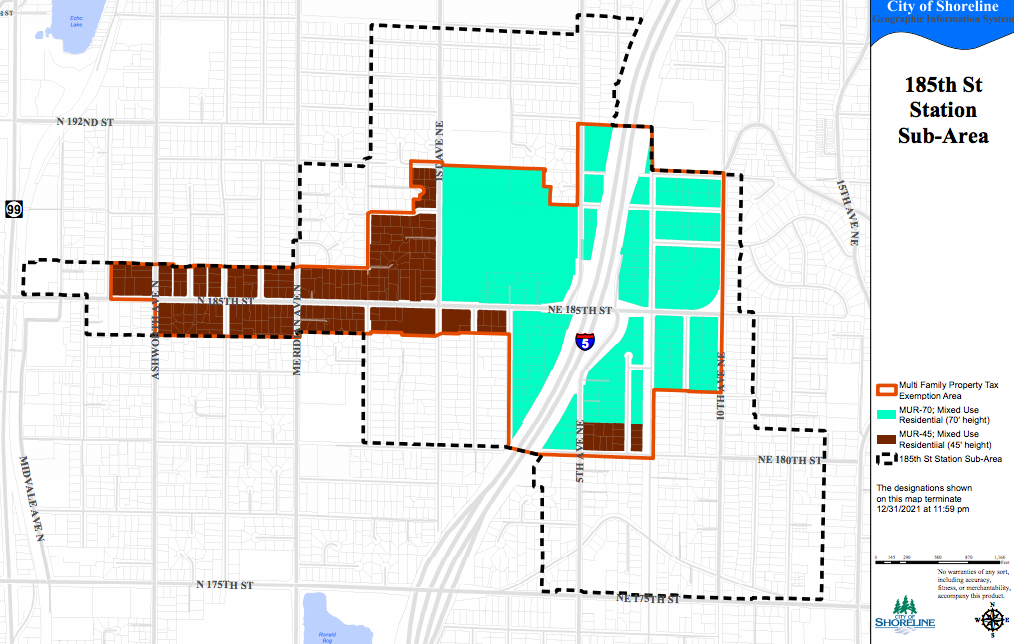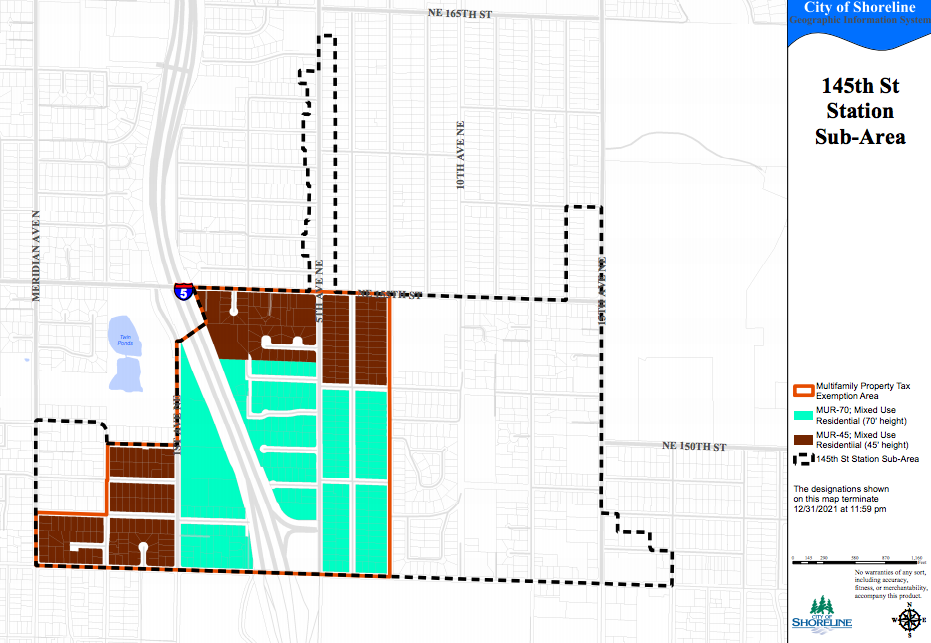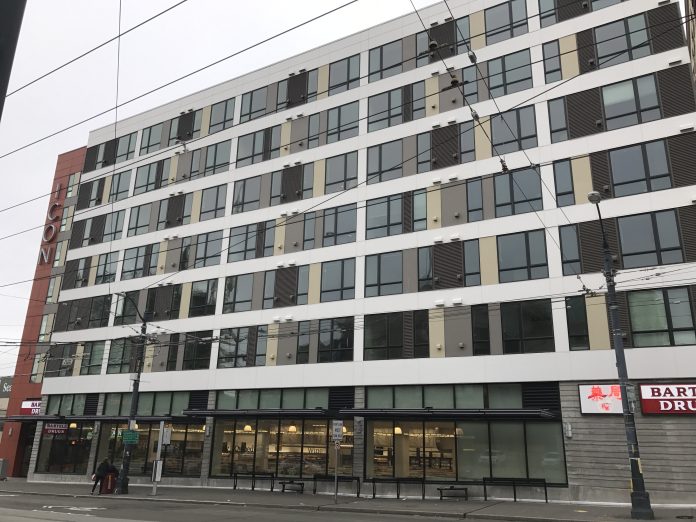Shoreline is expanding the city’s multi-family tax exemption (MFTE) program to guarantee rent- and income-restricted units and incentivize multi-family development. The program expansion will include areas around the city’s two future light rail stations where recent zoning plans have been drawn up to direct substantial dense urban growth over the coming years. At a meeting of the Shoreline City Council last week, the program expansion was passed on unanimous consent. Shoreline already has a modest MFTE program in place for the Aurora Square Community Renewal Area. Projects under the MFTE program require at least 20% of the total units to be set aside as affordable in order to qualify.
The primary purpose of Shoreline’s program, however, is not affordable housing per se but rather an incentive to encourage the construction of multi-family housing. According to city staff, the stated rationale for the program is to:
– Encourage increased residential opportunities within the residential targeted area;
– Stimulate new construction or rehabilitation of existing vacant and underutilized buildings for revitalization of the designated targeted areas;
– Assist in directing future population growth to the residential targeted area, thereby reducing development pressure on single-family residential neighborhoods; and
– Achieve development densities that stimulate a healthy economic base and are more conducive to transit use in the designated residential targeted area.
This makes sense in light of the fact that Shoreline has a mandatory housing affordability program in place for the station areas, which already requires 10% to 20% set-aside for rent- and income-restricted units. Developers have a choice in how they participate by unit type and affordability level, or alternatively paying a fee to the city instead. So in terms of the MFTE program, it mostly will only add extra affordable units if a developer chooses mostly 10% set-aside units under the mandatory program and an extra 10% affordable units at higher rents to temporarily satisfy the MFTE requirement of 20% set-aside for affordable units.
Station Area MFTE Program


Shoreline has designated properties zoned MUR-70 and MUR-45 in the 185th Street and 145th Street Station areas as eligible locations for the expanded MFTE program since larger mixed-use and multi-family developments are feasible in those areas. Staff recommended against offering eligibility in the MUR-35 zones since townhouse development is the most likely development typology, which they argued “would neither need nor appreciate the [MFTE] program.” A cap at 500 MFTE units for each station area was also proposed by staff, but not adopted in the final ordinance.
In addition to being proposed in an eligible zone, MFTE proposals will need to meet the following standards:
- Be associated with a multi-family housing or mixed-use project that would contain at least four dwelling units and where at least 50% of the building space would be provided with permanent residential occupancy;
- Affordable housing units would generally be required to reflect the mix and configuration of the standard units in the development;
- Achieve the general standards for mandatory housing affordability units (see section below); and
- Achieve the 20% affordability requirement tailored to the station areas (see table below); the 10% options only satisfy the mandatory affordability requirements, not the MFTE requirements.
| MUR-70+ | MUR-70 | MUR-45 | |
|---|---|---|---|
| Mandatory Participation | Yes | Yes | Yes |
| Incentives | Height may be increased above 70 ft.; may be eligible for 12-year property tax exemption upon authorization by City Council and no density limits. | May be eligible for 12-year property tax exemption upon authorization by City Council; and entitlement of 70 ft. height and no density limits. | May be eligible for 12-year property tax exemption and permit fee reduction upon authorization by City Council; entitlement of 45 ft. height and no density limits. |
| Studio, 1 bedroom | 20% of rental units shall be affordable to households making 60% or less of the median income for King County adjusted for household size; or 10% of rental units shall be affordable to households making 50% or less of the median income for King County adjusted for household size. | 20% of rental units shall be affordable to households making 70% or less of the median income for King County adjusted for household size; or 10% of rental units shall be affordable to households making 60% or less of the median income for King County adjusted for household size. | 20% of rental units shall be affordable to households making 70% or less of the median income for King County adjusted for household size; or 10% of rental units shall be affordable to households making 60% or less of the median income for King County adjusted for household size. |
| 2+ bedrooms | 20% of the rental units shall be affordable to households making 70% or less of the median income for King County adjusted for household size; or 10% of the rental units shall be affordable to households making 60% or less of the median income for King County adjusted for household size. | 20% of the rental units shall be affordable to households making 80% or less of the median income for King County adjusted for household size; or 10% of the rental units shall be affordable to households making 70% or less of the median income for King County adjusted for household size. | 20% of the rental units shall be affordable to households making 80% or less of the median income for King County adjusted for household size; or 10% of the rental units shall be affordable to households making 70% or less of the median income for King County adjusted for household size. |
The expanded MFTE program has a limited authorization period, which is planned to sunset on December 31, 2021 unless further extended. Developers who want to participate in the program would need to have complete applications submitted prior to the sunset date in order to take advantage of the program–though the program period could be extended. Under state law, MFTE programs are required limit to the period for property tax exemptions for participating properties to 12 consecutive years; Shoreline’s rules are consistent with this. Proposed MFTE applications would have to be approved by the Shoreline City Council, meaning that developers will need to convince the city that their proposals are worth signing off on if they want to get a tax break.
Relationship to City Mandatory Housing Affordability Program
In addition to the MFTE program, the station areas have an outright requirement for affordable housing development in all projects in the MUR-70 and MUR-45 zones, regardless of the proposed number of units. The affordable housing can be provided similar to Seattle’s mandatory housing affordability program as either on-site performance or in-lieu fee payment to the city. Developers, however, may still apply for the MFTE program if they otherwise meet the program requirements for the design of units, location, off-street parking, and open space.
Under the mandatory housing affordability provisions, rental units are required to remain affordable for 99 years while ownership units need only remain affordable for 30 years. The number of bedrooms for affordable units are required to be comparable to market-rate units and contain similar square footage for the equivalent market rate units, except in certain circumstances. Those units also must have the access to the same amenities such as swimming pools, community rooms, and parking and no fees for such facilities may be authorized unless all other units pay fees that are equal.
Aiming For Success
Shoreline has had some great success with their existing MFTE program, which has arguably jump-started some major construction projects that might otherwise not have happened. City officials believe that the same approach could help places like the 145th Street and 185th Street Station areas see quicker success, which ultimately would bring in a good chunk of affordable housing in addition to market-rate housing.
Stephen is a professional urban planner in Puget Sound with a passion for sustainable, livable, and diverse cities. He is especially interested in how policies, regulations, and programs can promote positive outcomes for communities. With stints in great cities like Bellingham and Cork, Stephen currently lives in Seattle. He primarily covers land use and transportation issues and has been with The Urbanist since 2014.



